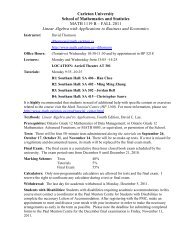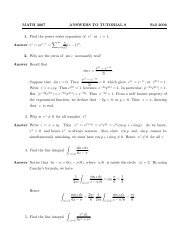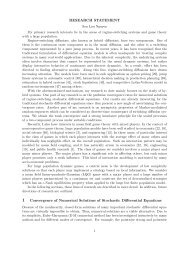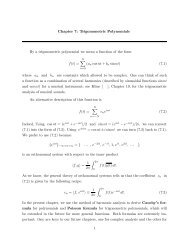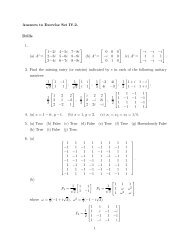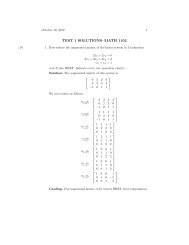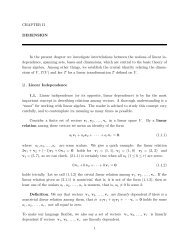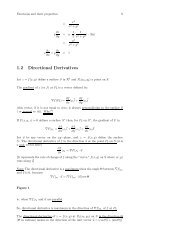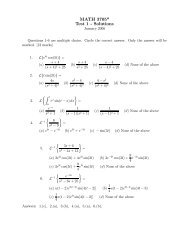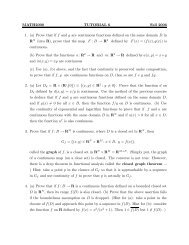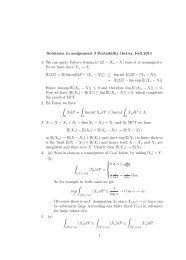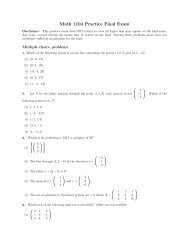MATH 3705 * B Test 2 - Solutions. February 2007
MATH 3705 * B Test 2 - Solutions. February 2007
MATH 3705 * B Test 2 - Solutions. February 2007
Create successful ePaper yourself
Turn your PDF publications into a flip-book with our unique Google optimized e-Paper software.
<strong>MATH</strong> <strong>3705</strong> * B <strong>Test</strong> 2 - <strong>Solutions</strong>. <strong>February</strong> <strong>2007</strong><br />
Questions 1-4 are multiple choice. Circle the correct answer. Only the answer will be marked.<br />
1. [3 marks] The general solution of 4x 2 y − 8xy +9y =0forx = 0is<br />
3<br />
−<br />
(a) C1|x| 2 + C2|x| 3<br />
2 (b) |x| 3<br />
2 (C1 + C2 ln |x|) (c) |x| 4+√7 (C1 + C2 ln |x|)<br />
(d) |x| 4<br />
√ √ <br />
C1 cos 7ln|x| + C2 sin 7ln|x|<br />
(e) None of the above<br />
Solution: The indicial equation is 4r(r − 1) − 8r +9=0, or 4r 2 − 12r + 9 = 0, with<br />
r1 = r2 = 12<br />
8<br />
3<br />
= , ⇒ Euler Equation, case (ii) ⇒ (b).<br />
2<br />
2. [3 marks] The general solution of x 2 y +4xy − 10y =0forx = 0is<br />
(c) |x| −2 (C1 + C2 ln |5x|)<br />
(d) |x| −2 [C1 cos (5 ln |x|)+C2 sin (5 ln |x|)] (e) None of the above<br />
(a) C1|x| 2 + C2|x| −5<br />
(b) C1|x| −2 + C2|x| 5<br />
Solution: The indicial equation is r(r − 1) + 4r − 10 = 0, or r 2 +3r − 10 = 0, with<br />
r1 =2,r2 = −5, ⇒ Euler equation, case (i) ⇒ (a).<br />
3. [3 marks] The equation 3xy + x 2 y + 1<br />
y =0has<br />
5<br />
(a) one regular singular point x =5.<br />
(b) one regular singular point x =0.<br />
(c) two regular singular points x =0andx =5.<br />
(d) one regular singular points x = 0 and one irregular singular point x =5.<br />
(e) no singular points.<br />
Solution: The equation in standard form is y + x<br />
3 y + 1<br />
1<br />
y =0, ⇒ q(x) =<br />
15x 15x<br />
analytic at x =0,butx 2 q(x) = x<br />
is, ⇒ (b).<br />
15<br />
is not<br />
4. [3 marks] The differential equation y + 7<br />
x +4 y + y = 0 has a singular point x0 = −4.<br />
∞<br />
Then the series solution y = an(x − 1) n about x = 1 has the radus of convergence<br />
n=0<br />
(a) R ≥ 1 (b) R ≥ 4 (c) R ≥ 5 (d) R = ∞<br />
Answers: b, a, b, c.
5. [6 marks] The differential equation y +2xy +2y = 0 has no singular points. The<br />
power series solution near x0 = 0 has the form y(x) =<br />
for the coefficients an.<br />
Solution:<br />
y =<br />
∞<br />
anx n , y =<br />
∞<br />
nanx n−1 , y =<br />
2<br />
∞<br />
anx n . Find the recursion relation<br />
n=0<br />
∞<br />
n(n − 1)anx n−2 .<br />
n=0<br />
n=0<br />
n=0<br />
Substituting y, y and y into the original equation yields<br />
∞<br />
n(n − 1)anx n−2 +<br />
n=0<br />
Combine the series for x n :<br />
∞<br />
n(n − 1)anx n−2 +<br />
n=0<br />
∞<br />
2nanx n +<br />
n=0<br />
∞<br />
2anx n =0.<br />
n=0<br />
∞<br />
2an(n +1)x n =0. (∗)<br />
n=0<br />
Notice that in the first series the first two terms, which correspond to n =0andn =1,are<br />
zeros. So the series does not change if the summation starts with n = 2. Then we shift the<br />
index of summation n → n + 2, and the series becomes<br />
∞<br />
n(n − 1)anx n−2 ∞<br />
= (n +2)(n +2− 1)an+2x n+2−2 ∞<br />
= (n +2)(n +1)an+2x n .<br />
n=2<br />
n+2=2<br />
Substituting the series above back to the equation (∗) yields<br />
∞<br />
(n +2)(n +1)an+2x n +<br />
n=0<br />
n=0<br />
∞<br />
2an(n +1)x n =0,<br />
which can be combined into one series as<br />
∞<br />
{(n +2)(n +1)an+2 +2an(n +1)} x n =0.<br />
n=0<br />
The above equation means that the series concerges to 0 for all x near x0, and therefore all<br />
the coefficients in the series must be zero:<br />
or<br />
n=0<br />
(n +2)(n +1)an+2 +2an(n +1)=0,<br />
an+2 = −2an<br />
n +2 .
6. [12 marks] The differential equation xy − 2xy − 2y = 0 has a regular singular point<br />
x0 = 0 and a power series solution near x0 =0.<br />
(a) [4] Show that r1 =1andr2 = 0 are the roots of the indicial equation.<br />
(b) [7] Find a power series solution, which corresponds to r1 =1.<br />
(c) [1] Give the first four terms of the series solution found in part (b).<br />
Solution:<br />
(a) Rewrite the equation in the standard form :<br />
y − 2y − 2<br />
y =0.<br />
x<br />
Here p(x) =−2, xp(x) =−2x, q(x) = −2<br />
x , x2q(x) =−2x.<br />
p0 =0,q0 =0 ⇒ r2 +(p0 − 1)r + q0 = r2 − r = r(r − 1) = 0 is an indicial equation. The<br />
roots are r1 =1,r2 =0.<br />
(b) The solution y(x) corresponding to r1 =1hastheform<br />
y =<br />
∞<br />
anx n+1 , with y =<br />
∞<br />
(n +1)anx n and y =<br />
n=0<br />
n=0<br />
n=0<br />
Substituting y, y and y into the original equation yields<br />
∞<br />
n(n +1)anx n −<br />
n=0<br />
∞<br />
2(n +1)anx n+1 −<br />
n=0<br />
After combining the series for x n+1 the equation becomes<br />
∞<br />
n(n +1)anx n −<br />
n=0<br />
∞<br />
n(n +1)anx n−1 .<br />
∞<br />
2anx n+1 =0.<br />
n=0<br />
∞<br />
2an(n +2)x n+1 =0. (∗)<br />
n=0<br />
Notice that in the first series the first term, which corresponds to n = 0, is zero. So the<br />
series does not change if the summation starts with n = 1. Thus, if we shift the index of<br />
summation n → n + 1 , then the series becomes<br />
∞<br />
n(n +1)anx n ∞<br />
= (n +1)(n +2)an+1x n+1 ∞<br />
= (n +1)(n +2)an+1x n+1 .<br />
n=1<br />
n+1=1<br />
Substituting the series above back to the equation (∗) yields<br />
∞<br />
(n +1)(n +2)an+1x n+1 −<br />
n=0<br />
n=0<br />
∞<br />
2an(n +2)x n+1 =0,<br />
n=0<br />
3
which can be combined into one series as<br />
∞<br />
{(n +1)(n +2)an+1 − 2an(n +2)} x n+1 =0.<br />
n=0<br />
The above equation means that the series converges to 0 for all x near x0. Therefore, all<br />
the coefficients in the series must be zero:<br />
or<br />
(n +1)(n +2)an+1 − 2an(n +2)=0,<br />
an+1 = 2an<br />
n +1 .<br />
Thus, we found the recurrence relation for the coefficients.<br />
n =0 ⇒ a1 =<br />
Let us solve it.<br />
2<br />
1 a0;<br />
n =1 ⇒ a2 = 2a1<br />
2<br />
n =2 ⇒ a3 = 2a2<br />
3<br />
n =3 ⇒ a4 = 2a3<br />
4<br />
2 2<br />
= ·<br />
2 1 a0;<br />
2 2 2<br />
= · ·<br />
3 2 1 a0;<br />
The pattern emerging for ak is<br />
2 2 2 2<br />
= · · ·<br />
4 3 2 1 a0;<br />
y =<br />
ak = 2k<br />
k! a0.<br />
∞<br />
anx n+1 =<br />
n=0<br />
(c) The first four terms of the solution:<br />
y =<br />
∞<br />
n=0<br />
∞<br />
n=0<br />
2 n a0<br />
n! xn+1 .<br />
2 n a0<br />
n! xn+1 = a0(x +2x 2 +2x 3 + 4<br />
3 x4 + ...).<br />
4



